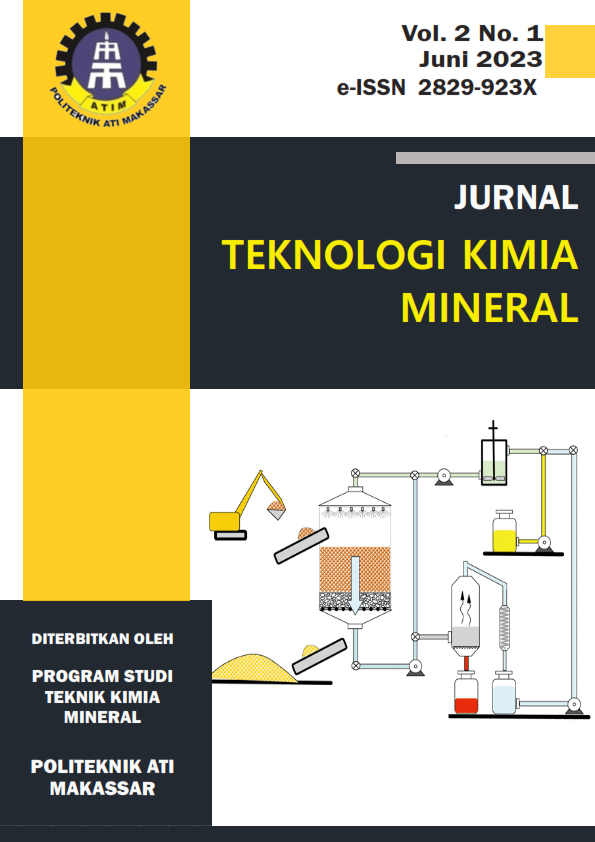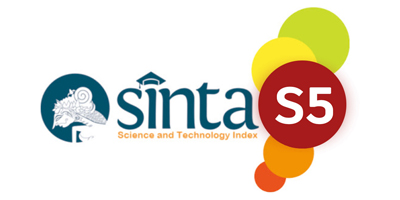ELUSI LOGAM TEMBAGA DAN KROM ABU LAYANG PEMBANGKIT LISTRIK TENAGA UAP
DOI:
https://doi.org/10.61844/jtkm.v2i1.441Kata Kunci:
Elusi, Abu layang, Tembaga, KromAbstrak
Penelitian elusi logam berat tembaga dan krom dari sampel abu layang pembangkit listrik tenaga uap (PLTU) Cirebon. Variabel dalam penelitian elusi logam tembaga dan krom dari abu layang PLTU adalah jenis eluen, konsentrasi eluen, pH eluen, dan elusi berkelanjutan. Kadar logam tembaga dan krom diukur menggunakan metode spektroskopi serapan atom (SSA). Sampel yang dielusi yang lolos ayakan ukuran 200 mesh. Kadar air dihilangkan dengan cara sampel abu layang di oven pada 105 oC selama 24 jam. Penelitian ini menggunakan paralon dalam pembuatan kolom. Proses elusi dilakukan dengan memasukkan abu layang di dalam kolom kemudian mengalirkan eluen ke dalam kolom. Eluen yang digunakan HCl, HNO3, dan H2SO4. Variasi konsentrasi eluen HNO3 dan HCl dari 0,5 M sampai 2 M sedangkan untuk H2SO4 0,1 M sampai 1,5 M. Variasi pH eluen dari 1 sampai 14. Elusi berkelanjutan menggunakan eluen HNO3 1,75 M untuk Cu dan HNO3 1,5 M untuk Cr. Hasil penelitian menunjukkan bahwa HNO3 eluen yang baik untuk mengelusi logam berat Cu dan Cr. Konsentrasi eluen yang paling baik adalah eluen HNO3 1,75 M untuk mengelusi logam berat Cu dari abu layang PLTU dengan konsentrasi 0,56 ppm sedangkan untuk logam berat Cr adalah eluen HNO3 1,5 M dengan konsentrasi 2,03 ppm. Logam Cr yang dapat terelusi secara berkelanjutan dengan eluen HNO3 1,5 M adalah 8,70% dan logam Cu dengan eluen HNO3 1,75 M adalah 9,16 %.
Unduhan
Referensi
M. H. Firmansyah, “PENGARUH EKSPOR MINYAK BUMI MENTAH DAN IMPOR PRODUK MINYAK BUMI OLAHAN TERHADAP PERTUMBUHAN EKONOMI INDONESIA,” E-Journal Ekonomi Pembangunan, vol. 11, no. 6, pp. 2045–2480, 2022.
C. R. Ward, D. French, J. Jankowski, M. Dubikova, Z. Li, and K. W. Riley, “Element mobility from fresh and long-stored acidic fly ashes associated with an Australian power station,” Int J Coal Geol, vol. 80, no. 3–4, pp. 224–236, Dec. 2009, doi: 10.1016/j.coal.2009.09.001.
Z. T. Yao, X. S. Ji, P. K. Sarker, J. H. Tang, L. Q. Ge, M. S. Xia, and Y. Q. Xi, “A comprehensive review on the applications of coal fly ash,” Earth Sci Rev, vol. 141, pp. 105–121, Feb. 2015, doi: 10.1016/j.earscirev.2014.11.016.
B. Cetin and A. H. Aydilek, “pH and fly ash type effect on trace metal leaching from embankment soils,” Resour Conserv Recycl, vol. 80, pp. 107–117, Nov. 2013, doi: 10.1016/j.resconrec.2013.09.006.
M. Izquierdo and X. Querol, “Leaching behaviour of elements from coal combustion fly ash: An overview,” Int J Coal Geol, vol. 94, pp. 54–66, May 2012, doi: 10.1016/j.coal.2011.10.006.
E. Sočo and J. Kalembkiewicz, “Investigations on Cr mobility from coal fly ash,” Fuel, vol. 88, no. 8, pp. 1513–1519, Aug. 2009, doi: 10.1016/j.fuel.2009.02.021.
H. Palar, Pencemaran & Toksikologi logam berat, 1st ed., vol. 1. Jakarta: Rineka Cipta, 2004.
G. Akar, M. Polat, G. Galecki, and U. Ipekoglu, “Leaching behavior of selected trace elements in coal fly ash samples from Yenikoy coal-fired power plants,” Fuel Processing Technology, vol. 104, pp. 50–56, Dec. 2012, doi: 10.1016/j.fuproc.2012.06.026.
G. Neupane and R. J. Donahoe, “Leachability of elements in alkaline and acidic coal fly ash samples during batch and column leaching tests,” Fuel, vol. 104, pp. 758–770, Feb. 2013, doi: 10.1016/j.fuel.2012.06.013.
S. Bahri, “Ekstraksi Kulit Batang Nangka menggunakan Air untuk Pewarna Alami Tekstil,” Jurnal Teknologi Kimia Unimal, vol. 8, no. 2, p. 73, Jul. 2020, doi: 10.29103/jtku.v8i2.2683.
M. L. D. Jayaranjan, E. D. van Hullebusch, and A. P. Annachhatre, “Reuse options for coal fired power plant bottom ash and fly ash,” Rev Environ Sci Biotechnol, vol. 13, no. 4, pp. 467–486, Dec. 2014, doi: 10.1007/s11157-014-9336-4.
M. C. Hsiao, H. P. Wang, and Y. W. Yang, “EXAFS and XANES Studies of Copper in a Solidified Fly Ash,” Environ Sci Technol, vol. 35, no. 12, pp. 2532–2535, Jun. 2001, doi: 10.1021/es001374v.
N. Habbache, N. Alane, S. Djerad, and L. Tifouti, “Leaching of copper oxide with different acid solutions,” Chemical Engineering Journal, vol. 152, no. 2–3, pp. 503–508, Oct. 2009
H. Grünewald, “Solubilities of Inorganic and Organic Compounds,” Angewandte Chemie, vol. 76, no. 19, pp. 832–832, Oct. 1964
C.-Y. Chang, C.-F. Wang, D. T. Mui, and H.-L. Chiang, “Application of methods (sequential extraction procedures and high-pressure digestion method) to fly ash particles to determine the element constituents: A case study for BCR 176,” J Hazard Mater, vol. 163, no. 2–3, pp. 578–587, Apr. 2009
Unduhan
Diterbitkan
Cara Mengutip
Terbitan
Bagian
Lisensi
Hak Cipta (c) 2023 Dhian Juwitasari

Artikel ini berlisensiCreative Commons Attribution-NonCommercial-ShareAlike 4.0 International License.













